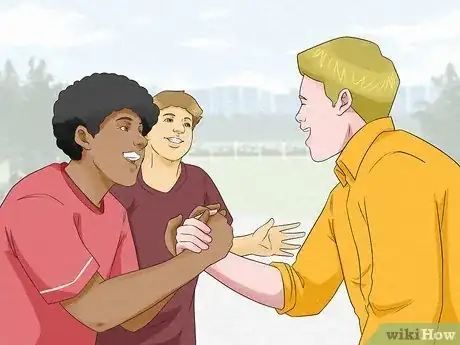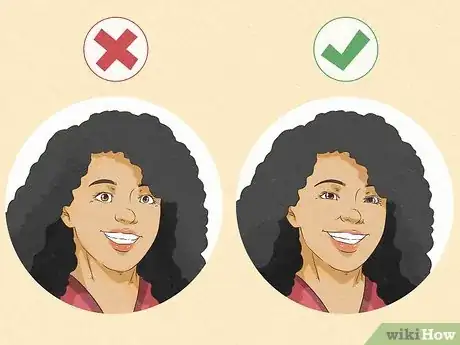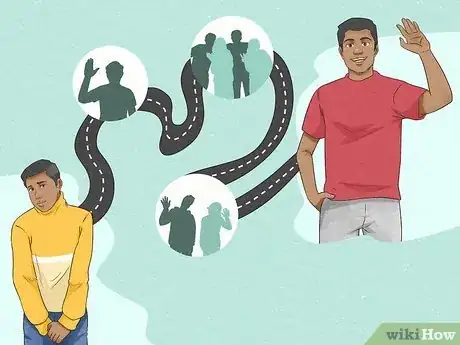This article was co-authored by Trudi Griffin, LPC, MS. Trudi Griffin is a Licensed Professional Counselor in Wisconsin specializing in Addictions and Mental Health. She provides therapy to people who struggle with addictions, mental health, and trauma in community health settings and private practice. She received her MS in Clinical Mental Health Counseling from Marquette University in 2011.
There are 32 references cited in this article, which can be found at the bottom of the page.
wikiHow marks an article as reader-approved once it receives enough positive feedback. This article received 12 testimonials and 84% of readers who voted found it helpful, earning it our reader-approved status.
This article has been viewed 1,223,412 times.
Some people are naturally outgoing, but other people have to practice to become outgoing. If you want to become outgoing, there are several strategies that you can use. Being “outgoing” involves learning how to present yourself to others, striking up conversations, and being more confident in yourself.
Things You Should Know
- Introduce yourself, give compliments, discuss common interests, and ask open-ended questions to become more outgoing in conversation.
- To socialize more regularly, join clubs, invite friends over, maintain your existing friendships, and introduce your friends to other people.
- To appear more friendly, focus on holding eye contact with others, active listening, holding great posture.
Steps
Mastering the Art of Conversation
-
1Start off small. No matter how obvious it may sound, it's helpful to actually realize that outgoing people didn’t go straight from the womb to parties. They had years of practice in safer environments: speaking to their siblings, joking with their classmates, and so on. You can simulate the natural way of becoming outgoing – by starting off small and proceeding incrementally. What’s a small step you can take today to do something slightly more outgoing than you used to do?
- Start with people you know, or, if you are starting fresh, find a small group of people that you share an interest with. A book club, sports team or hobby group is a great place to start. Try something new with this group such as participating in a bar crawl or arranging a barbecue and let people bring friends.
-
2Say thank you in public. You might see some of the same people every day, but never acknowledge them. To become outgoing, it is important to start acknowledging the people around you more often. The next time you order a coffee or check out at the grocery store, smile at the person helping you. Make eye contact and say, "thank you." This small gesture will help you become more comfortable interacting with others, and it will probably make the other person's day a little brighter.[1]
- A little compliment can also go a long way, especially in service situations. Remember that your grocery clerk or barista serves hundreds of people a day, many of whom probably either ignore them or are rude. Say something like, "Wow, thanks for getting that to me so quickly" to show your appreciation.
Advertisement -
3Make eye contact. If you're in a social situation, such as at a party, try to make eye contact with the other people there. Once you've established eye contact, give the other person a friendly smile. If the other person holds your gaze, then go over to them and introduce yourself. If the person smiles back at you, then that is also a good sign.
- If the person does not respond, let them go their way. There's a difference between being "outgoing" and "pushy." You don't want to force interaction on someone who isn't interested.
- Keep in mind that this approach doesn't work well in situations where people do not expect to be approached, such as while riding public transit. Part of being outgoing is knowing when and where to approach others and when to keep to yourself.
-
4Introduce yourself. You don’t have to be a suave charmer to be friendly and outgoing. Maybe try introducing yourself by saying you’re new to the area, or offering a compliment to the other person.
- Look for other “wallflowers.” You may not be comfortable jumping straight from “shy” to “social butterfly.” If you’re at a social function, try looking for other people who appear to be shy or holding back. Chances are, they feel as uncomfortable as you do. They’ll probably be happy that you made the first move to say “hello.”
- Be friendly, but not pushy. Once you’ve introduced yourself and asked a question or two, move on if the other person seems disinterested.
-
5Ask open-ended questions. One way to be more outgoing in your conversations with others is to ask them open-ended questions. These questions invite others to respond with more than a “yes” or “no.” It’s easier to start up a chat with someone new if you invite them to share about themselves.[2] If you've already exchanged eye contact and smiles with someone, and you're close by, start off with a question. Here are some ideas:
- How do you like that book/magazine?
- What is your favorite thing to do around here?
- Where did you find that awesome T-shirt?
-
6Give compliments. If you're interested in people, you're bound to notice little things that you like or appreciate. You can acknowledge these things with a compliment. Just make sure that your compliments are genuine. People can tell when compliments are not sincere. Think of something like:
- I've read that book. Great choice!
- I love those shoes. They go great with that skirt.
- Is that a hazelnut latte? Nice -- that's my go-to every Monday morning.
-
7Search for a common interest. First conversations between people are all about what the two parties have in common. In order to find out what you can talk about, you may have to probe for things you have in common. If you work together or have mutual friends or have anything that links you together, it should be a bit easier. Talking about work, your mutual friend, or your common interest will open up further topics of discussion.
- If this person is a stranger, you could use the situation to help you come up with something to talk about. For example, if you're in a bookstore, you could ask someone for a favorite reading recommendation. If you're both stuck in a long line, you could make a joke about it.
- Be careful to avoid comments that sound judgmental. For example, you could say you love the person's haircut and then ask where s/he got it done. Or you could say that you've been looking for a pair of sneakers like the ones the other person's wearing, and ask where s/he got them. Avoid things that are likely to seem offensive, such as comments on the person's size, skin color, or physical attractiveness.
-
8Pay attention to what excites people. If person A is dead set on talking about thermodynamics and person B is dead set on talking about Italian coffee, then the conversation isn't going to go anywhere. One of these people has to latch on to the other person's interests. Take the initiative and be that person.
- When you're making small talk, try to notice when the other person perks up. You'll be able to hear it and see it. Their face will be more expressive (and so will their voice) and you'll probably see movement in their body.
-
9Know that your flaws can turn into benefits. A common misconception is that people will like you more if you become "better." A bigger home, a faster car or a well-paid job look like great investments when it comes to making friends. The truth is there is no correlation between success and making real friends. People don’t like hanging out with those they feel subordinate to. Instead of trying to hide or kill your flaws, know that a weak paycheck, a bit of a belly, or spending too many hours watching TV only makes you more human and likable.
- Take yourself less seriously. You don't have to get people to know about the new sound system you bought or that cool place you went to for a vacation. Instead, you could tell stories about funny shortcomings.
- You don't have to stop improving, just do it for yourself instead of others.
-
10Chat up your coworkers. If you have a job, chances are you have an environment with built-in social contact if you make a little effort. Find a place where people tend to congregate, such as the break room or a coworker’s cubicle.
- The water cooler isn’t the place for heated topics, like religion or politics. Instead, try engaging people by remarking on popular culture or sports. While people often have strong opinions about these subjects too, they’re a safer bet to keep it conversation-friendly.
- Being outgoing at work can be important. By being more outgoing, people will perceive you as more friendly and positive.[3] Networking and chatting at work can also help you get the recognition at work that you deserve.
-
11End on a high note. Leave the other person wanting more. A good way to accomplish this is by leaving the door open for future interaction. Be gracious in exiting the conversation, so that the other person doesn’t feel as though you’ve ditched them.[4]
- For example, if you’ve been talking about your dogs together, ask about a good local dog park. If the other person responds positively, you could invite them to bring their dog to the park too: “Have you ever been to the dog park off Baxter Road? I haven't. What would you think of going together next Saturday?” Making a specific invitation is more effective than “let’s get together sometime” because it shows that you’re not just being polite.
- Once you’ve finished the conversation, wrap up by restating a main point you discussed. This will help the other person feel like you were listening to them. For example: “Good luck with that marathon on Sunday! I’d love to hear all about it next week.”
- End by affirming that you enjoyed the conversation. “It was really nice talking with you” or “It was so nice to meet you” help the other person feel valued.
-
12Talk to anyone and everyone. After you become a bit more comfortable talking to people you know, try talking to new people as you go through your day. At first you might feel uncomfortable talking with people you don’t know and who you might not normally approach. But the more you approach people and get comfortable with making conversation, the easier it will become.
Getting Out There
-
1Set specific, reasonable goals. Being outgoing is a tough goal to reach because it includes a lot of small behaviors. That is why it is a good idea to break this large goal down into smaller ones. Instead of telling yourself to be outgoing, set goals to have at least one conversation with a new person each day or to smile at five people every day.[5]
- Try to make small talk (or if that's too much, just smiling) with one stranger or acquaintance every day, say "hi" to someone on the street, or ask your barista’s name. These little victories will keep you going and make you feel ready for loftier challenges.
-
2Join a club. If you aren’t sure how to approach others in social settings, try joining a club for a particular interest. This gives you the opportunity to interact, usually in small-scale settings, with others who share an interest of yours.[6]
- Look for a club that encourages socializing, such as a book club or cooking class. You can ask questions and get into discussions, but the focus won’t be entirely on you. These situations can be great for shy people.
- Shared experiences can be a powerful bonding technique. Joining a club where you’ll share experiences with others gives you a head start -- you’ll already have common ground established.[7]
-
3Invite people over. You don’t even have to leave your house to be outgoing. Invite people to come over for a movie night or dinner party. If you’re welcoming and inviting, others will be more likely to feel as though you value them (and they’re more likely to have fun).
- Try creating events that will foster conversation. You could host a BYOB wine tasting, where everyone has to sip and compare notes. Or, you could hold a potluck dinner, where everyone has to bring their favorite dish of their grandmother’s (and a copy of the recipe). Having a reason to talk with each other helps a party stay lively and enjoyable (and, let’s be honest, food and wine never hurt).
-
4Master a hobby. A hobby can help you feel more in control, which may help you to be more outgoing.[8] If you master a hobby, then you may feel proud and confident as well, which can give you even more social confidence.[9]
- Hobbies also give you something to chat about with new acquaintances. They often give you a way to meet new people. And they have health benefits, such as a lower risk of depression.
-
5Dress for success. The way that you dress affects the way that you feel about yourself. Dressing in a way that expresses your personality and values can help you feel confident, and that will help you be more outgoing.
- If you’re a little nervous about socializing, wear something that makes you feel powerful and attractive. This will help you to carry that confidence into your interactions.[10]
- Clothes can also be great conversation-starters. Wearing a fun tie or a statement bracelet can be a way for others to break the ice with you. You can also compliment something someone else is wearing as a way to get acquainted.
- Be careful not to let judgments slip into these compliments, such as "That dress makes you look so thin!" That type of comment focuses on social standards of beauty rather than the person you're talking with. Instead, try something positive but nonjudgmental like "I love the design of that tie, it's so intricate" or "I've been looking for a pair of shoes like that, where did you get them?"
-
6Work on your existing friendships. Make sure to improve friendships with existing friends and the people you meet. Not only will you be more connected, but you'll be growing and gaining new experiences to share with both these groups of people.
- Old friends are good practice. They can introduce you to new people or accompany you to places you would never go alone. Don't ignore them! They're probably going through similar things, too.
-
7Introduce people to each other. Part of being outgoing is helping others feel comfortable. As you become more comfortable introducing yourself, spread the love by introducing other people to each other.
- Introducing people to each other helps ease social awkwardness. Think about what you know about each person -- what do they have in common? When you're talking to Janice from the yarn shop, take a moment to call out, "Hey, Steve! This is Janice. We were just talking about that new band at the Factory last night. What'd you think?"
Communicating With Your Body
-
1Examine your body language. Your nonverbal communication, such as body language and eye contact, can say as much about you as your actual words. The way that you hold your body sends messages about you to others.[11] People judge others as attractive, likeable, competent, trustworthy, or aggressive in a fraction of a second, so you may have only 1/10 of a second to make a first impression.[12]
- For example, making yourself “smaller” by crossing your legs, hunching, holding your arms, etc., communicates that you are not comfortable in a situation. It can send a message that you don’t want to interact with others.
- On the other hand, you can express confidence and power by opening yourself up. You don’t have to take more room than you need or intrude on others’ space, but establish space for yourself. Plant your feet firmly when you stand or sit. Stand with your chest out and shoulders back. Avoid fidgeting, pointing, or shifting your weight.[13]
- Your body language also affects how you feel about yourself. People who use “low power” body language, such as making yourself smaller or closing yourself off by crossing your legs or arms, actually experience increased cortisol, a stress hormone related to feelings of insecurity.[14]
-
2Make eye contact. You can be more outgoing just by making eye contact with others. For example, if you look directly at a person, this is commonly interpreted as an invitation. The other person returning your gaze acts as an acceptance of that invitation.
- People who make eye contact while speaking are often considered more friendly, open, and believable. Extroverts and socially confident people look more often, and for longer, at people they are speaking or interacting with.
- Eye contact produces a feeling of connection between people, even when the eyes are in photographs or even sketched.[15]
- Aim to maintain eye contact with the other person for about 50% of the time while you’re speaking, and for about 70% of the time while you’re listening. Hold your gaze for between 4-5 seconds before you break it again.[16]
-
3Express interest through body language cues. In addition to how you stand and sit when you’re on your own, you can communicate by using body language when interacting with others. “Open” body language communicates that you’re available and interested in the other person.[17]
- Open body language includes uncrossed arms and legs, smiling, and looking up and around the room.[18]
- Once you’ve established contact with someone, communicate your interest in them. For example, leaning in and tilting your head when they talk are ways to show that you’re engaged in the conversation and interested in the other person’s ideas.
- Many of these body language cues work to communicate romantic attraction, but they communicate non-romantic interest too.
-
4Be an active listener. When you’re listening to someone, show them that you’re engaged in the conversation. Focus on what they’re saying. Look at them while they speak. Nodding, using brief expressions such as “uh huh” or “mm hmm,” and smiling are all ways to show that you’re following the conversation.[19]
- Avoid looking over the person’s head or at another area of the room for more than a few seconds. This indicates that you’re bored or not paying attention.
- Repeat central ideas, or use them as part of your response. For example, if you’re talking with someone new at a bar who’s been telling you about her fly-fishing hobby, mention that when you respond: “Wow, I’ve never been fly-fishing. The way you describe it makes it sound like it would be fun, though.” This lets the other person know you really were listening, rather than mentally checking your shopping list or something else.
- Allow the other person to finish speaking before you respond.
- As you listen, don’t be planning your response to give as soon as they’re finished. Focus on the other person’s communication.
-
5Practice your smile. People can distinguish a “real” smile from a fake smile.[20] A real smile activates the muscles around your mouth and around your eyes. This is called a “Duchenne” smile.[21]
- Duchenne smiles have been shown to lower stress and produce feelings of happiness in the people who are smiling.[22]
- Try practicing a Duchenne smile. Imagine a situation in which you want to show a positive emotion, such as joy or love. Practice smiling to communicate that in front of a mirror. Check to see whether your eyes are crinkling at the corners -- a hallmark of the “real” smile.
-
6Push yourself past your “comfort zone.” You have a natural zone of “optimal anxiety,” or “productive discomfort,” that’s just outside your normal comfort zone. When you’re in this zone, you’re more productive because you’re willing to take risks, but you’re not so far outside your “safe space” that anxiety shuts you down. [23]
- For example, when you start a new job, go on a first date, or start at a new school, you probably try harder at first because the situation is new to you. This increased attention and effort improves your performance.[24]
- Take this process slowly. Pushing yourself too far or too fast can actually damage your ability to perform because your anxiety will move past the “optimal” level to “freak-out mode.” Try small steps outside your comfort zone at first. As you become more comfortable with the risks you take to achieve extroversion, you can take bigger ones.[25]
-
7Recast "failures" as learning experiences. With risk comes the possibility that the risk won't work out for you as you'd hoped. It can be tempting to view these situations as "failures." The problem with this way of thinking is that it's totalizing. Even in what looks like the worst possible outcome, there's something you can learn from to use the next time around.[26] [27]
- Consider how you approached the situation. What did you plan for? Is there anything you didn't plan for? With the benefit of experience now, what do you think you could do differently next time?
- What did you do to support your chances of success? For example, if your goal was to "socialize more," consider what actions you took. Did you go to a place where you knew a few people? Did you bring a buddy? Did you look for a place to hang out where you might find others who share interests with you? Did you expect to be a social butterfly immediately, or did you set your initial goals small and achievable? Scaffold for your success next time with the knowledge you have now.
- Focus on what you can control. Experiencing failure may make you feel powerless, as though you will never succeed no matter what. While some things are certainly beyond your control, some aren't. Think about what you do have the power to change, and consider how you can work those things to your advantage next time.
- You might tie their self-worth directly to your ability to perform. Learn to focus on your effort rather than its outcomes (which you may not be able to control all of the time). Practice self-compassion when you stumble. These techniques can be used as a way to do better next time.[28]
Thinking Positively, Effectively, and Confidently
-
1Challenge your inner critic. Changing your behaviors is hard, especially when what you’re trying to do doesn’t come naturally. You may hear that little voice that tells you things like “She doesn’t want to be your friend. You have nothing to add to the conversation. Anything you say will be stupid.” These thoughts are based on fear, not fact. Challenge them by reminding yourself that you have thoughts and ideas that others want to hear.[29]
- See if you can find evidence for these “scripts” when they run through your mind. For example, if your coworker walks by your desk and doesn’t say hello, your automatic response might be to think, “Wow, she’s really angry with me. I wonder what I did. I knew she didn’t want to be friends with me.”
- Challenge that thought by looking for evidence to support it; chances are, you won’t find much. Ask yourself: Has that person told you when they were angry before? If so, they’d probably have told you this time too. Have you actually done something to that person that might upset them? Is it possible they’re just having a bad day?
- You may be naturally shy and this might cause you to overestimate how your mistakes appear to others. Keep in mind that as long as you are open, honest, and friendly, most people won’t reject you for an occasional stumble. Beating yourself up over your mistakes can mean your anxiety keeps you from learning and growing.
-
2Be outgoing on your own terms. There is nothing wrong with being an introvert and being shy. Decide what you want to change about yourself, but do it for you, not because someone else suggested you should do so.
- Think about why being shy bothers you. Maybe it's just something that coming to terms with could solve. Or maybe you just want to be able to get more comfortable with talking with people around you. Being yourself as an introvert is much better than not being you and forcing extroversion.
- Think about when you find yourself in situations that rev up your shyness. How does your body respond? What are your inclinations? Figuring out how you operate is the first step to taking charge of your reactions.
-
3Start when you can. If you wait until you feel like doing something to do it, the chances are slim that you'll actually make the changes you want to see. You can increase your self-efficacy by acting the way you want to act -- regardless of whether you believe it at first. Your expectations are often enough to make something happen. That is why faking it till you make it works.[30]
-
4Set realistic goals. Remember that changing yourself takes time. Set realistic goals for yourself, and don't beat yourself up if you stumble now and then. This is normal.[31]
- Decide what challenges you. Realistic goals about being more outgoing might look different for you than for someone else. For example, making eye contact with one person each day might be a big victory for you. Choose goals that are realistic for you.
-
5Acknowledge that being outgoing is a skill. Even though it might seem like being outgoing comes easy for some people, that behavior was learned over time and you can learn it too.[32] By setting goals and continuing to work on being more outgoing, you can change how you react to situations and people.
- If you know some outgoing people, ask them questions. Were they always that way? Do they ever feel like they have to try to be outgoing? Do they have their own versions of social phobia? The answers will probably be no, yes, and yes. It's just something they've decided to take control of.
-
6Think of past successes. When you're at a party, that familiar anxiety might overtake you as you think about interacting with the other people there. You might have some negative thoughts about your ability to successfully interact with other people at the party. In this situation, think about situations where you successfully interact with people and feel comfortable. You're probably outgoing around family and friends, at least sometimes. Carry that success over to this situation.
- Thinking of all the times we did what we're currently afraid to do shows us that we are capable and makes us more confident.
References
- ↑ http://www.forbes.com/sites/amyanderson/2014/01/27/make-eye-contact-smile-and-say-hello/
- ↑ http://changingminds.org/techniques/questioning/open_closed_questions.htm
- ↑ https://www.psychologytoday.com/blog/cutting-edge-leadership/201110/why-extraversion-may-not-matter?collection=101164
- ↑ https://conversation-skills-core.com/how-to-end-conversation-positively/
- ↑ http://www.forbes.com/sites/lewishowes/2012/07/06/why-thinking-small-is-the-secret-to-big-success/
- ↑ https://www.psychologytoday.com/blog/changepower/201103/introverts-extroverts-and-habit-change?collection=101164
- ↑ http://www.huffingtonpost.com/2013/09/04/how-to-be-more-outgoing_n_3845174.html
- ↑ https://www.psychologytoday.com/blog/kidding-ourselves/201404/how-far-well-go-feel-in-control
- ↑ http://www.washingtonpost.com/business/capitalbusiness/career-coach-the-value-of-hobbies/2013/05/03/ffa53f2c-b294-11e2-bbf2-a6f9e9d79e19_story.html
- ↑ http://www.sciencedirect.com/science/article/pii/S0022103112000200
- ↑ https://www.ted.com/talks/amy_cuddy_your_body_language_shapes_who_you_are/transcript?language=en
- ↑ http://www.psychologicalscience.org/index.php/publications/observer/2006/july-06/how-many-seconds-to-a-first-impression.html
- ↑ http://changingminds.org/techniques/body/assertive_body.htm
- ↑ https://www.ted.com/talks/amy_cuddy_your_body_language_shapes_who_you_are#t-554799
- ↑ http://www.forbes.com/sites/carolkinseygoman/2014/08/21/facinating-facts-about-eye-contact/
- ↑ http://msue.anr.msu.edu/news/eye_contact_dont_make_these_mistakes
- ↑ https://www.scienceofpeople.com/attraction/
- ↑ http://www.huffingtonpost.com/vanessa-van-edwards/the-body-language-of-attraction_b_3673055.html
- ↑ http://www.mindtools.com/CommSkll/ActiveListening.htm
- ↑ http://www.theguardian.com/science/2015/apr/10/psychology-empathy-distinguish-fake-genuine-smiles
- ↑ https://www.psychologytoday.com/blog/thriving101/201001/what-science-has-say-about-genuine-vs-fake-smiles
- ↑ http://www.psychologicalscience.org/index.php/news/releases/smiling-facilitates-stress-recovery.html
- ↑ https://www.psychologytoday.com/blog/hide-and-seek/201207/can-anxiety-be-good-us
- ↑ http://www.wsj.com/articles/SB10001424052702303836404577474451463041994
- ↑ http://psychclassics.yorku.ca/Yerkes/Law/
- ↑ https://hbr.org/2011/04/strategies-for-learning-from-failure
- ↑ http://www.huffingtonpost.com/guy-winch-phd/learning-from-failure_b_4037147.html
- ↑ http://greatergood.berkeley.edu/article/item/how_to_help_kids_overcome_fear_of_failure
- ↑ http://msue.anr.msu.edu/news/abcs_of_changing_your_thoughts_and_feelings_in_order_to_change_your_behavio
- ↑ https://www.psychologytoday.com/blog/the-empathic-misanthrope/201109/fake-it-til-you-make-it
- ↑ https://www.psychologytoday.com/blog/notes-self/201308/how-set-goals
- ↑ http://www.livescience.com/16216-outgoing-shy-personality-nature-nurture.html
About This Article
To be outgoing, start by being polite to others, which can include saying "thank you," making eye contact, and introducing yourself to strangers. In conversation, ask open-ended questions and give sincere compliments to other people about things that you like. When you're talking to someone you just met, search for a common interest, like a favorite movie, musical genre, or book, which can help open up conversation. If you want to be outgoing and meet new people, try joining clubs or picking up a new hobby. For tips from our counselor reviewer on being confident in your conversation skills, read on!































































































